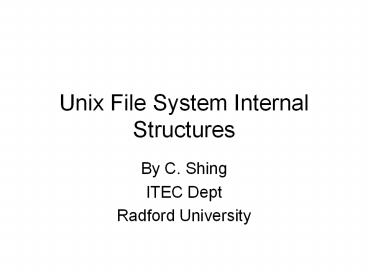Unix File System Internal Structures - PowerPoint PPT Presentation
1 / 16
Title:
Unix File System Internal Structures
Description:
Understand partition and file system. Understand the file system components ... fdisk /dev/fd0. create/modify disk partition table. System Components. File System ... – PowerPoint PPT presentation
Number of Views:154
Avg rating:3.0/5.0
Title: Unix File System Internal Structures
1
Unix File System Internal Structures
- By C. Shing
- ITEC Dept
- Radford University
2
Objectives
- Understand partition and file system
- Understand the file system components
- Understand the component structure
- Understand the difference between file and
directory - Understand how a new file is stored
- Understand how Unix search file through directory
tree
3
Partition and File System
- Partition logically independent disk, accessed
by own devices (SCSI disk supports 8 sd, IDE disk
can have 4 hd) - A file system has directory structure, created
to store and retrieve data in files and directory
(using disk blocks) - Note One file system is usually on one partition
4
File System Type
- ext2 for Linux
- ufs for SVR4
- hsfs or iso9660 for CD-ROM
- msdos or pcfs for DOS
5
Filesystem - Creation
- Unix commands
- mkfs ext2 /dev/fd0
- construct a filesystem
- format t ext2 /dev/fd0
- format, repair and analyze disk
- fdisk /dev/fd0
- create/modify disk partition table
6
System Components
- File System
- Boot block disk block 0
- Super-block disk block 1
- Inode table disk block 2 on
- Data blocks disk block starts after inode
table blocks
7
System Components boot block
- Sometimes called MBR (Master Boot Record) in
Windows - Contains bootstrap program and disk partition
table
8
System Components super-block
- Similar to Windows Boot Block
- A bitmap of blocks
- 1 block used
- 0 free block
- A bitmap of inode
- 1 inode used
- 0 inode block
- Note newer system has super-block back-up to
prevent system corruption
9
System Components inode table
- List of inodes (index nodes) starts from inode
2 - Inode 128 Bytes size, represents file, unique in
a file system, contains - Meta-data
- Direct block pointers 10, points to data block
- Indirect block pointers 4GBgt file size gt 40K(for
4K block) - Double block pointers file size gt 4 GB
- Note Inode 1 not used bad block (location of
un-usable blocks), prevent from allocating to
other files
10
System Components data block
- Store actual user data (contents of file)
11
File and Directory
- File stream of bytes, represented by inode
- Directory filenames and their location of inodes
12
File and Directory
- Example
- File inode
Meta-data Data Block location
13
File and Directory
- Example
- Directory /
Name Inode Number
. 2
.. 2
adminrootfile 100
/usr 32704
14
Store New File
- When a new file is created, the file system will
perform the following - Find a free inode (from super-block) to store
file properties - Find a free block (from super-block) to store the
file contents from Kernel buffer - Store the block number in the inode
- Puts filename and the inode number in the current
directory
15
Directory/File Traversal
- Starts from / (. has inode 2)
- Find the subdirectory name
- Find its inode number and its block number
- Go to the block
- Go back to step 2, until filename is found
16
Reference
- Ch. 14 Unix Internals































